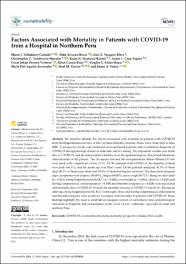Factors Associated with Mortality in Patients with COVID-19 from a Hospital in Northern Peru

View/
Download
(application/pdf: 1.091Mb)
(application/pdf: 1.091Mb)
Date
2023-03-23Author(s)
Valladares-Garrido, Mario J.
Alvarez-Risco, Aldo
Vasquez-Elera, Luis E.
Valdiviezo-Morales, Christopher G.
Martinez-Rivera, Raisa N.
Cruz-Zapata, Annel L.
Pereira-Victorio, César Johan
Garcia-Peña, Elian
Failoc-Rojas, Virgilio E.
Del-Aguila-Arcentales, Shyla
Davies, Neal M.
Yáñez, Jaime A.
Metadata
Show full item recordAbstract
We aimed to identify the factors associated with mortality in patients with COVID-19 from the hospitalization service of the Cayetano Heredia Hospital, Piura, Peru, from May to June 2020. A prospective study was conducted in hospitalized patients with a confirmed diagnosis of COVID-19 through serological and/or molecular reactive testing. The dependent variable was death due to COVID-19, and the independent variables were the epidemiological, clinical and laboratory characteristics of the patient. The chi-square test and the non-parametric Mann–Whitney U test were used, with a significance level of 5%. Of 301 patients with COVID-19, the majority of them were male (66.1%), and the mean age was 58.63 years. Of the patients analyzed, 41.3% of them died, 40.2% of them were obese and 59.8% of them had hepatic steatosis. The three most frequent signs/symptoms were dyspnea (90.03%), fatigue (90.03%) and a cough (84.72%). Being an older adult (p = 0.011), being hospitalized in the ICU (p = 0.001), overweight (p = 0.016), obese (p = 0.021) and having compromised consciousness (p = 0.039) and thrombocytopenia (p = 0.024) were associated with mortality due to COVID-19. Overall, the mortality rate due to COVID-19 was 41.3%. Having an older age, being hospitalized in the ICU, overweight, obese and having compromised consciousness and thrombocytopenia were positively associated with mortality in patients with COVID-19. These findings highlight the need to establish an adequate system of surveillance and epidemiological education in hospitals and communities in the event of new outbreaks, especially in rural and northern Peru.
Collections
- SCOPUS [380]

